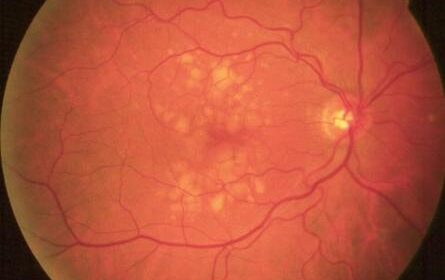(AMD) are expected to boost the growth of the global dry age-related macular degeneration (AMD) market at a CAGR of 8.62% during the forecast period 2021 to 2027 :
The dry AMD market is expected to register a CAGR of 8.62% during the forecast period of 2021 to 2027.
the key players in the global dry AMD market—Santen Pharmaceuticals Inc. (Japan), Allergan plc (Ireland), Bausch Health (Canada), Alimera Science Inc. (US), Phio Pharmaceuticals Corp (US), Ocumension Therapeutics Co. Ltd (China), Belite Bio Inc. (US), Kubota Vision Inc. (US), Iveric Bio (US), Eyestem Research Pvt Ltd (India), Yuyang DNU Co., Ltd (South Korea), and Stealth Biotherapeutics Inc. (US).
Market Highlights
The global dry AMD market is expected to register a CAGR of 8.62% during the forecast period and hit USD 6,113.33 million by 2027.
Age-related Macular Degeneration (AMD) is classified as either dry macular degeneration or wet macular degeneration. Neovascular macular degeneration may proceed to wet (neovascular) AMD, marked by blood vessels growing under the retina and leaking. Dry-type occurs more frequently, although it tends to go more slowly over the years. In general, moist-type tends to produce a change in vision that happens rapidly, culminating in severe vision loss.
The growth of the dry AMD market worldwide is attributed to the growing geriatric population and increasing prevalence of age-related macular degeneration, and the introduction of novel treatment methods for dry AMD coupled with an increasing number of clinical trials focused on dry AMD. Other factors like increasing healthcare expenditure are likely to help the market grow. However, the high number of failed clinical trials for dry AMD drugs might hamper the market growth to some extent.
Segment Analysis
The global dry AMD market has been divided based on stages, age group, route of administration, diagnosis& treatment, and end user.
The market, based on stages, has been segregated into early age-related macular degeneration, intermediate age-related macular degeneration, and late age-related macular degeneration.
Based on age group,the dry AMD market has been divided into above 75 years, above 60 years, and above 40 years.
Based on diagnosis & treatment, the dry AMD market has been divided into treatment and diagnosis.Treatment type is further bifurcated into nutrition therapy and telescopic lens implant. Nutrition therapy is again divided into antioxidants and others. Antioxidants are also segregated as vitamins, zinc, copper, omega-3 fatty acids, and others.
Diagnosis is bifurcated into fluorescein angiogram, preliminary test, optical coherence tomography, and others.
Based on the route of administration, the market is bifurcated into oral, intravitreal, and others.
On the basis of end user, the market is bifurcated into hospitals and clinics, diagnostic centers, academic research institutes, and others
Regional Analysis
The global dry AMD market, based on region, has been divided into North America, Europe, Asia-Pacific, and the Rest of the World. North America dominated the global dry age-related macular degeneration market owing to the rising number of patients suffering from the condition. The increasing number of diabetic patients adds to the number of patients suffering from ophthalmologic conditions. The number of patients with retinal diseases such as dry AMD, retinal vein occlusion, and diabetic eye disease is steadily increasing in the US, according to a retrospective study presented during The Association for Research in Vision and Ophthalmology 2020.Europe holds the second largest market share due to the increasing older population and rising patient population. Additionally, improving government initiatives, increasing healthcare frames, and the rising demand for technologically innovative treatments are driving the growth of the dry age-related macular degeneration market in Europe.The Asia-Pacific is the fastest-growing market for age-related macular degeneration as it is developing at a very rapid pace and has shown the emergence of many players. Moreover, the rising prevalence of eye disorders, increasing healthcare spending, and multinational companies moving towards the developing nations and setting operational set-ups are likely to drive the growth of the market. The Rest of the World is expected to witness a restricted growth due to limited access and healthcare affordability among the population. This region is segmented into Middle East, Africa, and Latin America. In the Middle East, the growth of the market is driven by increasing healthcare infrastructure and healthcare expenditure.
Key Findings of the Study
-
- The global dry AMD market was valued at USD 3,431.65millionin 2020 and is projected to register a CAGR of8.62% during the assessment period.
-
- North America accounted for the largest market share due to the rising number of patients suffering from the condition.
-
- Based on stages, the intermediate AMDsegment accounted for the largest market share of 46.00% in 2020.
-
- On the basis of age group, the above 40years segment is expected to register the highest CAGR of 10.27% during the forecast period.
-
- By diagnosis and treatment, the treatment segment accounted for the largest market size of USD 2,166.42 million in 2020.
-
- Based on route of administration, the oral segment accounted for the largest market size of USD 2,207.18 million in 2020.
-
- By end user, the hospitals &clinicssegment accounted for the largest market size of USD 1,724.14 million in 2020.
-
- Allergan plc (Ireland), Bausch Health (Canada), and Eyestem Research Pvt Ltd (India)are the key market players.
Photoelectric Sensor Market Outlook 2030: Industry Insights & Opportunity Evaluation, 2019-2030

